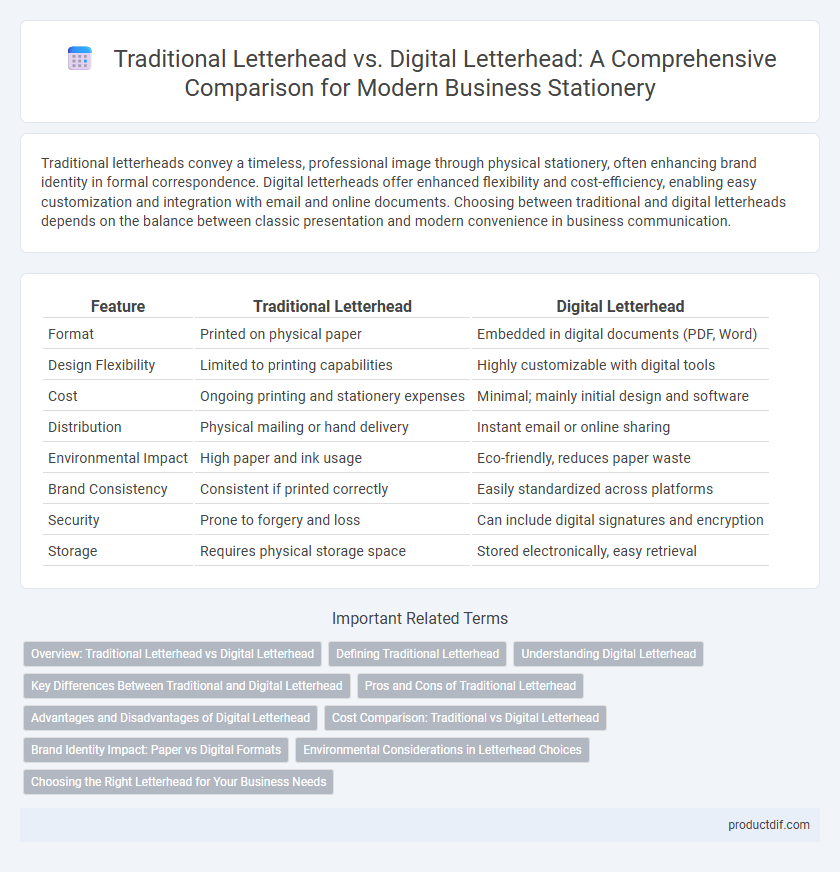Traditional letterheads convey a timeless, professional image through physical stationery, often enhancing brand identity in formal correspondence. Digital letterheads offer enhanced flexibility and cost-efficiency, enabling easy customization and integration with email and online documents. Choosing between traditional and digital letterheads depends on the balance between classic presentation and modern convenience in business communication.
Table of Comparison
| Feature | Traditional Letterhead | Digital Letterhead |
|---|---|---|
| Format | Printed on physical paper | Embedded in digital documents (PDF, Word) |
| Design Flexibility | Limited to printing capabilities | Highly customizable with digital tools |
| Cost | Ongoing printing and stationery expenses | Minimal; mainly initial design and software |
| Distribution | Physical mailing or hand delivery | Instant email or online sharing |
| Environmental Impact | High paper and ink usage | Eco-friendly, reduces paper waste |
| Brand Consistency | Consistent if printed correctly | Easily standardized across platforms |
| Security | Prone to forgery and loss | Can include digital signatures and encryption |
| Storage | Requires physical storage space | Stored electronically, easy retrieval |
Overview: Traditional Letterhead vs Digital Letterhead
Traditional letterhead features pre-printed designs on physical paper, ensuring consistent brand presentation in formal correspondence and legal documents. Digital letterhead utilizes customizable templates in digital formats, enhancing flexibility and reducing printing costs while maintaining professional appearance in electronic communication. Both options serve branding purposes, but digital letterhead supports eco-friendly practices and integration with modern office software.
Defining Traditional Letterhead
Traditional letterhead is a printed stationery element featuring a company's logo, name, and contact details, typically positioned at the top of a physical letter. It serves as a formal branding tool, often incorporating high-quality paper, embossing, or foil stamping to convey professionalism and authenticity. This classic format supports official correspondence and legal documentation, maintaining a tangible brand presence.
Understanding Digital Letterhead
Digital letterhead offers enhanced customization and easy integration with email and electronic document formats, streamlining professional communication. It supports dynamic elements like clickable links, embedded logos, and contact details that update automatically, increasing brand consistency. Unlike traditional letterheads, digital versions reduce printing costs and paper waste, aligning with sustainable business practices.
Key Differences Between Traditional and Digital Letterhead
Traditional letterheads are typically printed on high-quality paper featuring embossed logos and formal typography, while digital letterheads are created electronically with customizable templates and can be integrated into emails and digital documents. The permanence and tactile quality of traditional letterheads contrast with the flexibility and eco-friendliness of digital letterheads that enable instant edits and global distribution. Security features also differ; traditional letterheads often use watermarking and special inks, whereas digital versions incorporate encryption and digital signatures for authenticity.
Pros and Cons of Traditional Letterhead
Traditional letterhead offers a tangible and professional appearance that enhances brand credibility through high-quality paper and printing techniques. However, it incurs higher costs related to printing, postage, and storage, while lacking the flexibility and instant distribution capabilities of digital letterheads. The environmental impact of traditional letterheads also poses a downside, as paper usage contributes to waste and limits sustainability compared to digital alternatives.
Advantages and Disadvantages of Digital Letterhead
Digital letterheads offer significant advantages such as easy customization, cost savings on printing and paper, and seamless integration with email communication, enhancing brand consistency across digital platforms. However, they may face challenges like security concerns, potential email delivery issues, and reliance on technology for proper display across different devices and software. Despite these drawbacks, digital letterheads provide a sustainable and efficient alternative to traditional printed letterheads in modern business communications.
Cost Comparison: Traditional vs Digital Letterhead
Traditional letterheads involve higher costs due to printing, paper quality, and bulk orders, averaging $100 to $500 for 500 sheets, while digital letterheads require minimal expenses limited to design software and template creation. Digital letterheads offer significant savings by eliminating ongoing printing and material fees, reducing overall stationery expenses by up to 70%. Businesses adopting digital letterheads benefit from cost-efficiency and scalability with virtually zero incremental costs per additional use.
Brand Identity Impact: Paper vs Digital Formats
Traditional letterheads enhance brand identity through tactile quality, color accuracy, and physical presence, reinforcing professionalism and trust with recipients. Digital letterheads offer versatility and instant distribution, allowing brands to maintain consistent visual elements across multiple platforms and devices. Paper formats evoke tangible brand recognition, while digital formats enable dynamic incorporation of interactive elements and real-time updates.
Environmental Considerations in Letterhead Choices
Traditional letterheads involve paper production and ink usage, leading to higher carbon footprints and increased deforestation impact. Digital letterheads use electronic formats that significantly reduce paper waste and energy consumption associated with printing and distribution. Choosing digital letterheads supports sustainable office practices by minimizing resource use and promoting environmentally friendly communication.
Choosing the Right Letterhead for Your Business Needs
Traditional letterheads offer a tangible, professional impression with custom embossed designs and high-quality textured paper that appeal to clients valuing formality and brand heritage. Digital letterheads provide versatile, cost-effective solutions compatible with electronic communications, enabling easy customization, quick distribution, and eco-friendly practices for modern business operations. Selecting the appropriate letterhead depends on factors such as target audience expectations, branding consistency, communication channels, and budget considerations to optimize corporate identity and operational efficiency.
Traditional Letterhead vs Digital Letterhead Infographic

 productdif.com
productdif.com